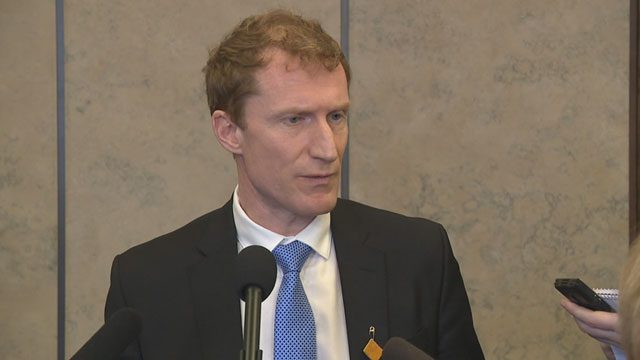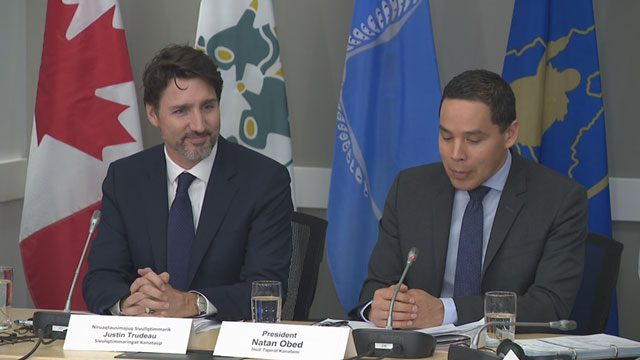
Indigenous Services Canada (ISC) unveiled its preparedness plan for COVID-19’s potential impact in First Nations and Inuit communities on Thursday morning.
Valerie Gideon, senior assistant deputy minister at the First Nations Inuit Health Branch, held a briefing for parliamentarians.
The eight page document included a plan to estimate need for personal protective equipment (PPE) “based on past experience with H1N1” and deploy this equipment “as requested by communities.”
Watch more from APTN’s Jamie Pashagumskum in Ottawa.
ISC said it’s developing “surveillance systems used for influenza to track COVID-19 data.”
Other measures included developing an early warning system, increased communication, collaborating with other federal departments, and increasing “surge capacity response.”
Read the entire briefing here.
“The most expedient thing is to increase our capacity and to have a sensitive and appropriate approach, in particular to hand-washing but also the capacity to self-isolate,” Marc Miller, Indigenous Services minister, told the Indigenous and Northern Affairs standing committee.
Health professionals are warning that COVID-19 could disproportionately impact Indigenous communities.
COVID-19 is a viral infectious disease of the coronavirus family that was discovered when an outbreak began in Wuhan, China in December according to the World Health Organization (WHO).
It was classified as a global pandemic on Wednesday.
“Indigenous peoples suffer extreme disparities when it comes to the standard of healthcare that they receive in comparison to the general population,” Dr. Sean Hillier, professor in the Faculty of Health at York University, told APTN News.
Hillier is Mi’kmaw and a member of the Qalipu First Nation.
He has studied and taught extensively in the field of Indigenous health.
“We have a fairly young overall population. Many Indigenous people in Canada are living with morbidities and co-morbidities. We have a death rate that is between six and 15 years younger than the average Canadian,” he added.
Some Indigenous communities deal with substandard living conditions and inequal social determinants of health. There is a housing crisis in the North that leads to overcrowding. There are 61 long-term drinking water advisories on reserves. Remoteness can create barriers to accessing health care services. Urban centres face higher rates of Indigenous homelessness.
Indigenous peoples deal with higher rates of pre-existing conditions such as tuberculosis, chronic obstructive pulmonary disorder, malnutrition, diabetes, and HIV/AIDS.
Hillier said these and other factors place Indigenous communities at greater risk.
“Infectious diseases are running rampant in communities and have been uncontrolled for many years. Indigenous people are really the only people in this country dying of preventable infectious disease.”
“Certainly, I would anticipate that COVID-19’s impact on Indigenous people will be greater than the general population. This is going to follow trends with virtually every other infectious disease.”
He said the government needs a plan to get protective equipment, hand sanitizer, ventilators, and more nurses to remote communities in the North.
Miller told the committee ISC is looking at “the optionality of having isolation tents.”
Hillier said this is “urgently needed to deal with a lack of community infrastructure to deal with an outbreak and we can not wait until we have confirmed cases to do so.”

(Justin Trudeau and ITK President Natan Obed. Photo: APTN)
Natan Obed, president of Inuit Tapiriit Kanatami (ITK) told APTN he raised “Inuit-specific” concerns in discussions with the government about COVID-19
“There are very specific concerns that any plan will have to incorporate, especially in relation to things like the continuity of health service delivery in remote communities who only have health centres staffed by nurses rather than hospitals that are staffed by doctors, and then also the overcrowding in our homeland that will prevent some of the public health measures that are being advocated for, such as self-isolation,” he said.
“We also have concerns about that way medical supplies and goods and services especially food can continue to flow in and out of our communities in the face of COVID-19 realities in the country.”
Despite the concerns, he said ITK has “every indication that the government of Canada is serious about the Inuit-specific concerns.”
Read more:
Federal government sets millions aside for Indigenous communities as WHO declares COVID-19 pandemic
Niki Ashton, NDP MP for Churchill—Keewatinook, disagreed. She was at the briefing and told reporters after question period that the federal government isn’t taking the threat serious.
“What we heard in the briefing today and from the minister in committee today is that they are monitoring. There’s reference to equipment and there’s reference to self-testing but not actually addressing the key factors behind why First Nations communities are more vulnerable and why a spread would be so much faster,” she said.
“It is clear to us over the last few days that the government is not taking this seriously. You can look at the fact the Indigenous Services minister is not a permanent member, wasn’t part of the historic announcement yesterday and is continuing to move on this issue with a lack of urgency and frankly a lack of communication with leaders on the ground.”
Despite being an “alternate member” of the COVID-19 committee, Miller insists he is fully engaged in committee meetings and planning.
On Wednesday, Prime Minister Justin Trudeau announced $1-billion to combat the virus. The figure includes $100-million, a portion of which goes toward “ongoing support for preparedness in First Nations and Inuit communities.”
Trudeau and his wife Sophie-Gregoire Trudeau are currently in self-quarantine after she exhibited flu like symptoms after arriving home from a foreign trip.
“We have been promised by the prime minister’s office an Inuit-specific carve-out in that allocation,” said Obed.
“We don’t know what that will look like as of this afternoon. We are pleased that the government is taking a distinctions-based approach and also has articulated very clearly the Inuit-specific concerns are going to be a part of the government response.”
Despite the greater risk for Indigenous communities, Public Health Agency of Canada (PHAC) said the risk for the “general population” is low.
The number of locally transmitted cases in Canada is zero. All infected individuals had travelled outside of the country.
with files from Jamie Pashagumskum










